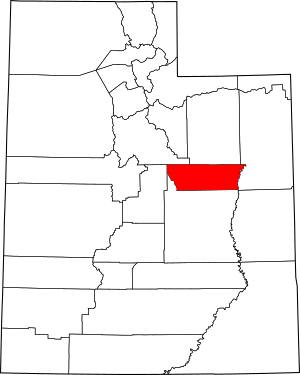National Register of Historic Places listings in Carbon County, Utah facts for kids
This article is about the amazing historical places in Carbon County, Utah, that are listed on the National Register of Historic Places. This special list helps protect important buildings, sites, and objects across the United States. In Carbon County, there are over 300 places on this list! Most of them are ancient sites found in a famous area called Nine Mile Canyon.
Contents
What is the National Register of Historic Places?
The National Register of Historic Places is like a hall of fame for important historical and archaeological sites in the U.S. When a place is added to this list, it means it's recognized for its special history, architecture, or archaeological value. This helps to preserve these places so future generations can learn from them.
Nine Mile Canyon: An Outdoor Art Gallery
Most of the historic places in Carbon County are found in Nine Mile Canyon. This canyon is often called the "longest art gallery in the world" because it has so much ancient rock art!
Ancient Art: Petroglyphs and Pictographs
The canyon is home to hundreds of archaeological sites, many of which feature incredible rock art.
- Petroglyphs are images carved into rock surfaces. Ancient people used tools to scratch or peck away the dark outer layer of rock, revealing lighter rock underneath.
- Pictographs are images painted onto rock surfaces. They used natural pigments, like minerals mixed with water or animal fat, to create colorful drawings.
These artworks tell stories about the people who lived here long ago, including the Fremont people and later the Ute people. They show animals like bighorn sheep, human-like figures, and mysterious symbols.
What We Find at These Sites
Besides rock art, many sites in Nine Mile Canyon include:
- Granaries: These were small storage buildings, often made of stone and mud (adobe), where ancient people kept their harvested food safe.
- Pit-houses: These were homes built partly underground, providing shelter from the weather.
- Rock shelters: Natural overhangs or caves in cliffs that people used for shelter.
- Walls and rock alignments: Structures built from stones, possibly for defense, marking boundaries, or other purposes.
- Artifacts: Tools, pottery pieces (ceramics), and other items left behind by ancient inhabitants.
Many of these sites are protected and their exact locations are kept secret to prevent damage.
Other Historic Places in Carbon County
While Nine Mile Canyon holds many ancient secrets, Carbon County also has other important historical buildings and areas. These places tell the story of more recent times, like the early towns and communities that grew in Utah.
Some examples include:
- The Albert and Mariah Bryner House in Price.
- The Hellenic Orthodox Church of the Assumption in Price, a beautiful church with a long history.
- The Helper Commercial District in Helper, which shows what a busy town center looked like in the past.
- The Price Municipal Building, an important building for the city's government.
- Old post offices in Helper and Price, which were vital communication hubs.
These buildings help us understand how people lived, worked, and built communities in Carbon County over the years.
Former Listing
One property, the Giacomo and Maria Bruno House and Farmstead in Helper, was once on the National Register but has since been removed because it was demolished.
Images for kids



















